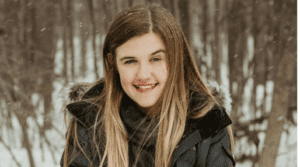Diagnosed at 10 Months
Kyleigh
Story Written by Author/Self

My favorite word for the past year has been the word “continue” because choosing to continue was the only decision I could make on my own. I was the only person who could decide if I was going to wake up the next morning and make the best of my situation. I wrote the word anywhere and everywhere. It became “my word” that I held onto because despite my limitations, I was still responsible for this choice.
On March 1st, 2006, I was born a seemingly healthy baby. I started sleeping through the night at six weeks old and reached every milestone at exactly the right time. However, we had no idea what was lied ahead.
In January 2007, my parents noticed something was wrong. I had become increasingly lethargic and was vomiting frequently. I was first diagnosed with the flu, but after my symptoms persisted, we headed to the hospital. An MRI showed my ventricles were enlarged and my brain was being “squished” due to an inoperable, pea-sized tumor called a tectal glioma. I was diagnosed with obstructive hydrocephalus, also known as non-communicating hydrocephalus.
Neurosurgeons urgently informed my parents that I needed emergency brain surgery to insert an external ventricular drain (EVD) to relieve the pressure on my brain, but to expect severe brain damage as my prognosis. Thankfully, only hours after my surgery, I was fully alert and lively, beginning my “career” of proving statistics wrong. Once I was stable the EVD was removed, and my neurosurgeon treated my hydrocephalus by performing an Endoscopic Third Ventriculostomy (ETV).
The next year and a half were eventful. Shortly after returning home, I began leaking CSF from my incision. This resulted in the placement of another EVD and the insertion of a ventriculoperitoneal (VP) shunt. After my third shunt revision in the Spring of 2008, my body finally “accepted” the shunt. I became a relatively normal kid who loved to learn and be around people. I feel my only limitation is that I have a programmable valve, that can be adjusted from outside the body.
Until I was about 12 or 13, I didn’t feel different from my peers because everything was working great. I didn’t realize having a problem with my shunt was a possibility. In 2018, I started to get headaches, but I chalked it up to growing and dehydration. I noticed them becoming more frequent in 2019, but they were not getting worse. Doctors assumed I was having migraines, so my headaches weren’t researched further. In addition, I realized my neck mobility was becoming more limited as the years went by.
For the next two years, I became used to chronic headaches and developing mobility issues. I was doing well in school, playing on the volleyball team, and pursuing my interests in music and anything medically related. However, things changed drastically in 2022. My chronic headaches became severe and my immobility was so extreme that when I got my driver’s permit, I couldn’t do a shoulder check. After an appointment, my neurosurgeon told me that my shunt catheter had become calcified because I had my shunt for 14 years. This is an uncommon circumstance since an estimated 50% of shunts in the pediatric population fail within two years of placement and repeated neurosurgical operations are often required. In July 2022, I was hospitalized for a severe headache, intense nerve pain, and a red line along my shunt tract. I was told that my shunt was starting to break down, and I was reacting to it.
The next few months my symptoms persisted and were worse than ever. I would have weeks where I couldn’t sit up because of my headache or have anything touch where my shunt was located due to the nerve pain, and I was on morphine only to take the edge off my pain.
In late September, my neurosurgeon decided it would be in my best interest if I had my shunt replaced. It was not a decision I took lightly, but I knew this is what needed to be done. 
Surgery day came and was ruled a success. The shunt they took out was so old it broke in the surgeon’s hands! Except… later that night, my shunt started to fail. I have no memory of this period, but it was an intense time. I had emergency surgery the next morning to put a new shunt in.
That evening, I regained consciousness and from that moment on started recovering without any deficiencies. Day five post-op was the first day in over three years I didn’t have pain! Since then, I’ve been pain-free. If I hadn’t chosen to continue during that time, I would’ve missed this incredible experience! Choosing to continue feels like a privilege, and I love doing it every day!
HA is continuing the fight for Kyleigh and all who live with hydrocephalus. Donate and help us with the fight!
Tell us about your journey with hydrocephalus!
Share your story of hope and perseverance with us! We will feature the amazing individuals in our community who are living life to the fullest regardless of their condition! Stories are reviewed by our staff and posted on our website and through social media. Stories should be no more than 800 words long. Click here to submit your story today!
Let’s SHARE. Let’s CONNECT. Let’s raise AWARENESS! Let’s INSPIRE!
For questions, email: communications@hydroassoc.org with the subject line “Share Your Story”.
Become a Grassroots Advocate for Hydrocephalus today! Visit our Advocacy Action Center.
